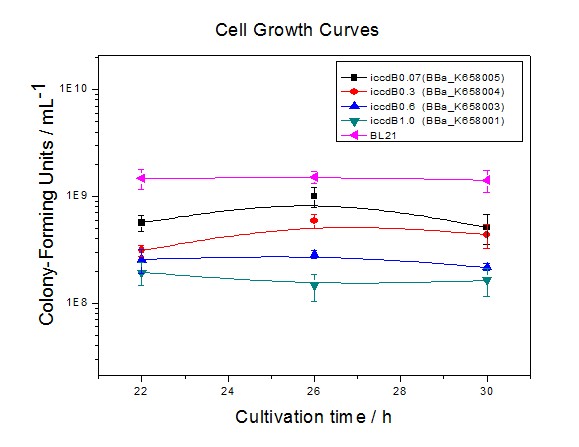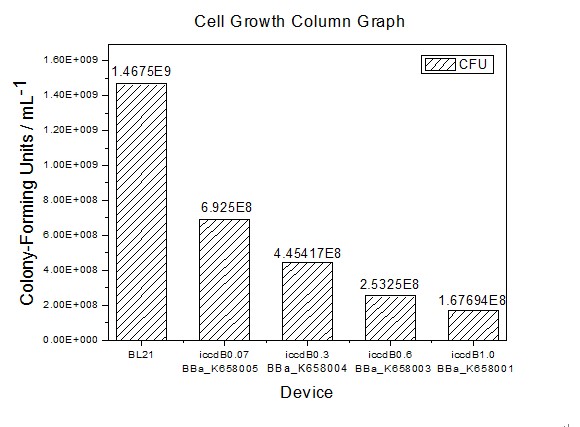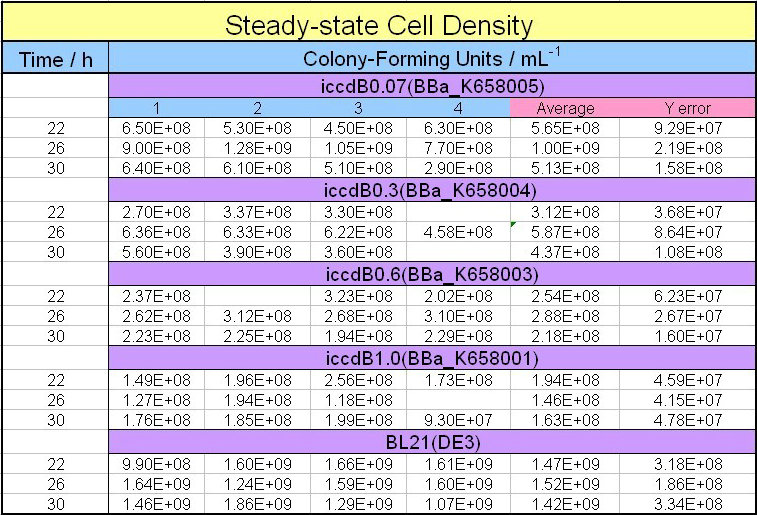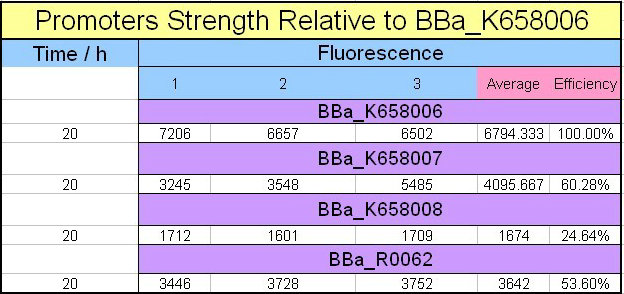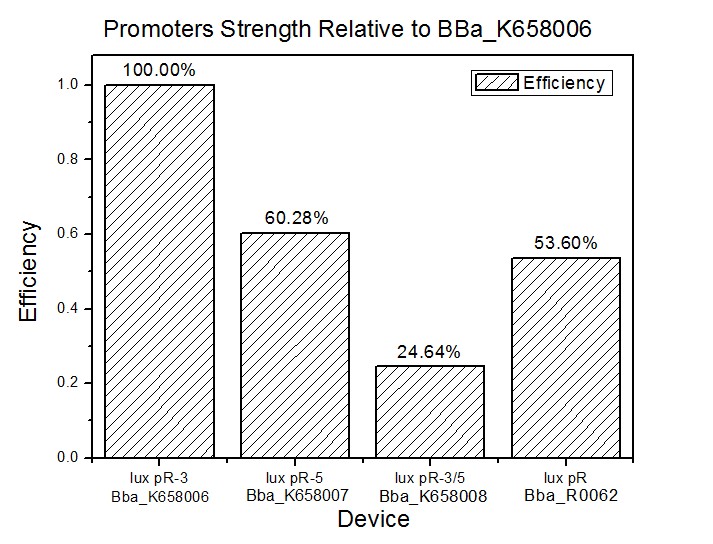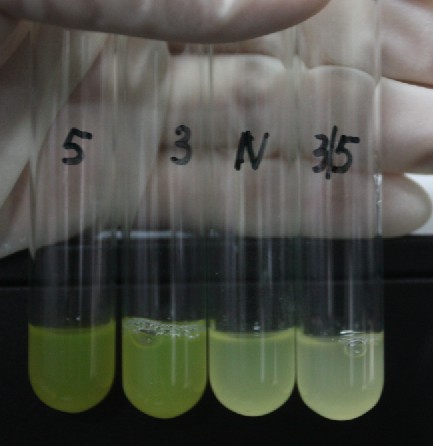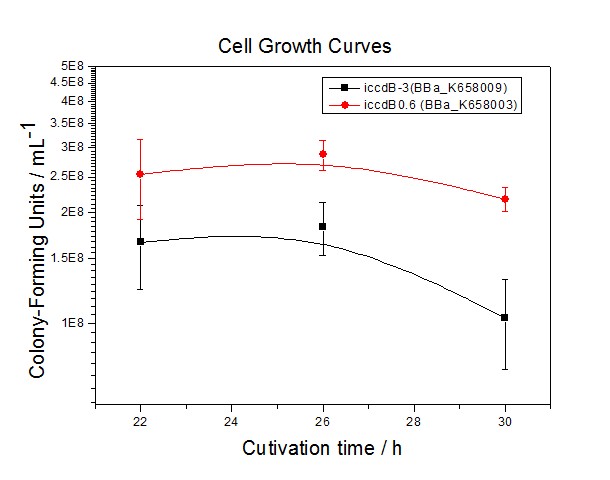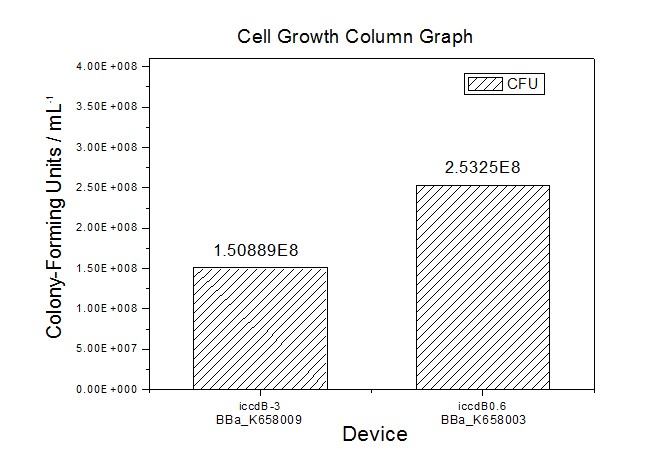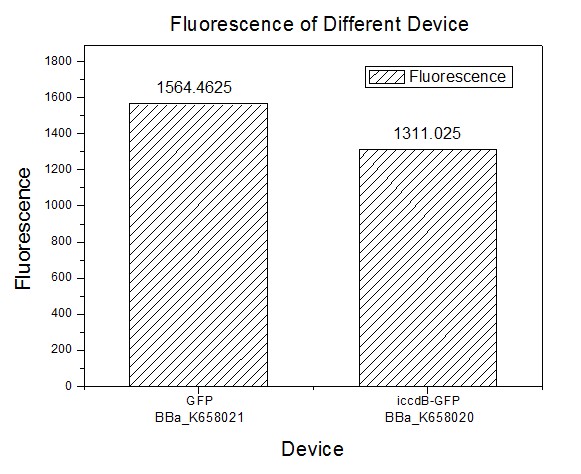Team:XMU-China/Result
From 2011.igem.org
(Difference between revisions)
(→iccdB->GFP) |
|||
| Line 13: | Line 13: | ||
[[Image:XMU_China_113.jpg|left|Figure 1 Experimentally measured growth curves of BL21’ cells without iccdB0.07 (red dot) and with iccdB0.07 ON (black dot).|frame|Figure 1 Experimentally measured growth curves of BL21’ cells without iccdB0.07 (red dot) and with iccdB0.07 ON (black dot).]] | [[Image:XMU_China_113.jpg|left|Figure 1 Experimentally measured growth curves of BL21’ cells without iccdB0.07 (red dot) and with iccdB0.07 ON (black dot).|frame|Figure 1 Experimentally measured growth curves of BL21’ cells without iccdB0.07 (red dot) and with iccdB0.07 ON (black dot).]] | ||
| - | == | + | ==Population-control devices with RBS of different strength== |
[[Image:XMU_China_114.jpg|left|Figure 2 Experimentally measured densities of BL21’s cells without population-control circuit and BL21’s cells with four population-control circuits respectively at steady state|frame|Figure 2 Experimentally measured densities of BL21’s cells without population-control circuit and BL21’s cells with four population-control circuits respectively at steady state.]] | [[Image:XMU_China_114.jpg|left|Figure 2 Experimentally measured densities of BL21’s cells without population-control circuit and BL21’s cells with four population-control circuits respectively at steady state|frame|Figure 2 Experimentally measured densities of BL21’s cells without population-control circuit and BL21’s cells with four population-control circuits respectively at steady state.]] | ||
| Line 27: | Line 27: | ||
Figure 2, figure 3 and table 1 illustrate that by using RBS of different strength in the population-control device, we were able to control the steady-state cell density of a bacteria population at different levels. And a population-control device with RBS of high strength results in a low steady-state cell density. It might be explained by the mechanism that for circuit-regulated growth, the cell death rate is regarded proportional to the intracellular concentration of the killer protein. The expression of the killer gene is regulated by the strength of its upstream RBS. Therefore, a RBS with higher strength promises more killer protein in vivo, which leads to a higher death rate of the bacteria population. | Figure 2, figure 3 and table 1 illustrate that by using RBS of different strength in the population-control device, we were able to control the steady-state cell density of a bacteria population at different levels. And a population-control device with RBS of high strength results in a low steady-state cell density. It might be explained by the mechanism that for circuit-regulated growth, the cell death rate is regarded proportional to the intracellular concentration of the killer protein. The expression of the killer gene is regulated by the strength of its upstream RBS. Therefore, a RBS with higher strength promises more killer protein in vivo, which leads to a higher death rate of the bacteria population. | ||
| - | == | + | ==Strength of promoter lux pR and its mutants== |
Four lux pR strength testing devices (BBa_K658016 BBa_K658017 BBa_K658018 BBa_K658019) were first cloned into plasmid pSB1A2 respectively, followed by transformation into E.coli strain BL21. Fluorescence was measured when cell growth reached a steady state (around 20h). | Four lux pR strength testing devices (BBa_K658016 BBa_K658017 BBa_K658018 BBa_K658019) were first cloned into plasmid pSB1A2 respectively, followed by transformation into E.coli strain BL21. Fluorescence was measured when cell growth reached a steady state (around 20h). | ||
| Line 48: | Line 48: | ||
| - | == | + | ==Population-control devices with mutated promoters== |
[[Image:XMU_China_120.jpg|left|Figure 7 Experimentally measured steady-state cell density of iccdB0.6(BBa_K658003) and iccdB-3 (BBa_K658009)|frame|Figure 7 Experimentally measured steady-state cell density of iccdB0.6(BBa_K658003) and iccdB-3 (BBa_K658009).]] | [[Image:XMU_China_120.jpg|left|Figure 7 Experimentally measured steady-state cell density of iccdB0.6(BBa_K658003) and iccdB-3 (BBa_K658009)|frame|Figure 7 Experimentally measured steady-state cell density of iccdB0.6(BBa_K658003) and iccdB-3 (BBa_K658009).]] | ||
Revision as of 23:33, 5 October 2011
 "
"


